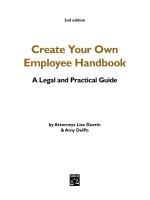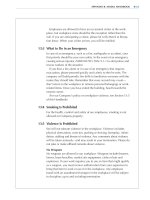create your own employee handbook a legal and practical guide phần 2 ppsx
Bạn đang xem bản rút gọn của tài liệu. Xem và tải ngay bản đầy đủ của tài liệu tại đây (366.97 KB, 44 trang )
CHAPTER
2
At-Will Protections
One of the first—and probably the most important—policies to
include in your handbook is an at-will statement. This policy con-
firms that your employees work at will: that is, you can fire them at
any time and for any reason that is not illegal and they can quit at
any time they like. This policy gives you some very important legal
protection against lawsuits. If an employee sues you, claiming that
your handbook, your unwritten personnel practices or statements
by your company managers constituted a promise that he or she
would not be fired except for good cause, an at-will policy in your
handbook will be your best defense.
The law generally presumes that your employees work at will
unless they can prove otherwise. As evidence, they’ll need to show
that they entered into an employment contract with you that
changed the at-will relationship. If you enter into a written employ-
ment contract that limits your right to fire an employee—such as a
contract that the employee will work for you for a specified period
of time, or a contract stating that the employee may only be fired
for specified reasons (misconduct, criminal behavior or good cause
are common examples)—that employee no longer works at will.
These written contracts won’t be affected by the sample at-will
policy we provide—and you don’t want them to be. In those
relatively rare situations when you really need an employee to
come on board (or stay there) for a set period of time, offering an
employment contract that limits your right to fire will help you seal
the deal.
If an at-will policy sounds harsh to you, remember that it will
help you preserve your managerial prerogatives over the rest of
your workforce. Even if employees don’t have written contracts of
employment, they can still argue that you promised, either outright
or by implication, not to fire them without good cause. These
employees will point to conversations with managers (“He said I
would always have a position with the company, as long as my
sales numbers were strong”), your personnel practices (“The
2/2 CREATE YOUR OWN EMPLOYEE HANDBOOK
company has never fired someone without a good reason”) or offi-
cial company statements (“At ABC company, we believe that our
employees are our greatest asset—and we treat them accordingly”)
to argue that they had an unwritten contract of employment that
limits your right to fire at will.
Throughout this book, we show you how to write policies that
will not undermine your at-will rights. But legal claims could still
arise—“oral contract” claims if the employee argues that you made
an explicit promise limiting your right to fire, or “implied contract”
claims if the employees argues that your statements and actions
indicated that you had limited your right to fire. To defeat these
claims, you will need something more than an at-will policy. You’ll
also need a form for your employees to sign agreeing to their at-
will status. You’ll find both in this chapter, where, we cover:
2:1 At-Will Policy 2/3
Form A: Handbook Acknowledgment Form 2/6
Need more information on
at-will employment and
employment contracts? You can find
it in Dealing with Problem Employees,
by Amy DelPo &Lisa Guerin (Nolo),
which explains at-will employment
in detail. It also covers employment
contracts, including the kinds of
evidence an employee might use to
try to prove that you made an implied
contract (and tips on how to avoid
creating this evidence in the first place).
The book also contains a sample at-
will offer letter that you can modify
for use in your own company.
AT-WILL PROTECTIONS 2/3
2:1 At-Will Policy
Your at-will policy should clearly state that you retain the right to
fire employees at will and that nothing in your handbook constitutes
a contract or promise to the contrary. You should also designate
someone (or more than one person) who is solely authorized to
make employment contracts on behalf of the company—this will
allow you to relinquish your at-will rights if you need or want to
for a particular employee.
Standard Policy
Employment Is At Will
We are happy to welcome you to [Company name]. We sincerely
hope that your employment here will be a positive and rewarding
experience. However, we cannot make any guarantees about your
continued employment at
[Company name]. Your employment
here is at will. This means that you are free to quit at any time, for
any reason, just as we are free to terminate your employment at any
time, for any reason—with or without notice, with or without
cause.
No employee or company representative, other than
, has the authority to change the at-will
employment relationship or to contract with any employee for
different terms of employment. Furthermore,
may change the at-will employment relationship only in a written
contract, signed by
and the employee.
Nothing in this Handbook constitutes a contract or promise of
continued employment.
Who Needs This Policy
Some employers, particularly small businesses, “mom and pop”
enterprises and companies with trusted, long-term employees,
wonder if they want an at-will policy. After all, they are not planning
to fire workers without a good reason, so why adopt a policy that
says they can? The reason is simply to hedge your bets. Even if you
never plan to act without good cause, your safest course of action
is to adopt an at-will policy that preserves your right to do so, just
2/4 CREATE YOUR OWN EMPLOYEE HANDBOOK
in case. If a worker you fire decides to challenge your decision in a
lawsuit, you won’t have to prove that you had good cause for your
actions—you can simply point to your at-will policy. Most judges
will be easily convinced to throw out the worker’s contract claim
very early on in the lawsuit, saving you from spending a lot of time
and money justifying your decisions.
And the truth is, employers cannot know ahead of time that they
will never have to rely on an at-will policy. Sometimes, an employee
just doesn’t work out, for reasons that you can’t quite put your
finger on or couldn’t prove conclusively in court. If you have a
clear at-will policy, you can simply fire that worker and move on.
If you don’t, your safest legal bet might be to keep the worker on,
gathering evidence and documenting problems until you’re sure
that you can prove good cause to fire. For as long as it takes, the
worker will keep on mucking up the works, while you spend
some of your time building a legal case—instead of running your
business.
Despite the benefits of an at-will policy, some employers choose
not to adopt one. And there are a few advantages to foregoing an
at-will policy, with improved employee relations topping the list.
Workers are generally not happy to open an employee handbook
and read that they can be fired at any time, for any reason. If you
promise to give your workers a fair shake, you might reap some
rewards—like improved loyalty and more positive attitudes towards
your company.
Only you can decide whether you want to assert your at-will
rights in your handbook. Given the clear benefits of having such a
policy—and the real dangers of leaving one out—we strongly
recommend that all employers adopt an at-will policy, whether
they plan to rely on it or not. There are plenty of other ways to
show your employees that you value their work.
How to Complete This Policy
The sample policy above provides a space where you should name
a company officer who can modify the at-will relationship. This
provision gives you the discretion to enter into employment con-
tracts that limit your right to fire, while at the same time protecting
your at-will rights over the rest of your workforce.
Most companies will want to designate the highest company
officer—for example, the president, CEO or owner of the company.
Take care to select someone at the highest echelons of company
management—you want the company to have complete control
AT-WILL PROTECTIONS 2/5
over who gets an employment contract and who doesn’t. And
designate this person by position (for example, the president of the
company) rather than by name. Although you may not anticipate
any changes in your company ladder, you never know what the
future might bring. By omitting any names from this policy, you
ensure that the policy won’t require any changes if your company
has a personnel shake-up.
Some companies designate more than one person who can
make contracts. This is fine as long as you authorize only a few
people, at most. The more people who have the right to make
contracts, the higher the likelihood that there will be contracts that
you don’t know about.
2/6 CREATE YOUR OWN EMPLOYEE HANDBOOK
Form A: Handbook Acknowledgment
Form
If you decide to have an at-will policy (see discussion above), you
should also ask employees to sign an at-will acknowledgment form.
To anyone who isn’t a lawyer, it probably seems like overkill to
have both a policy and a form that essentially restates that policy.
But in the legal world, redundancy is not only encouraged, it is
sometimes required. In this case, using both a policy and an
acknowledgment form gives you more protection against future
lawsuits.
Using an acknowledgment form offers you two important benefits.
First, it will prevent your employees from arguing that they didn’t
know about or read the at-will policy in your handbook. While
some courts might listen to such an argument—especially if that
policy was buried deep in a thousand-page manual—all courts
presume that people read a written agreement before signing it.
Second, a signed, written agreement legally trumps agreements in
less reliable forms—like an oral agreement or an implied contract.
While a written policy helps your argument, it is not a contract—it
will weight the scales strongly in your favor, but might not deliver
the knockout blow. But a signed written agreement is generally
conclusive. Courts are not interested in hearing people argue “well
yes, I signed it, but I thought it didn’t apply to me.” If an employee
tells a court that you entered into an oral or implied agreement not
to fire him without good cause, the signed acknowledgment form
should put a stop to that claim.
Your handbook acknowledgment form should explain the
importance of the handbook, state that the handbook can be
changed at any time and does not constitute a contract of continued
employment, and explain the at-will policy again—this time, so
your workers can sign the form to acknowledge their understanding
of the policy.
AT-WILL PROTECTIONS 2/7
Handbook Acknowledgment Form
By signing this form, I acknowledge that I have received a copy of
the Company’s Employee Handbook. I understand that it contains
important information about the Company’s policies, that I am
expected to read the Handbook and familiarize myself with its
contents and that the policies in the Handbook apply to me. I
understand that nothing in the Handbook constitutes a contract or
promise of continued employment and that the Company may
change the policies in the Handbook at any time.
By signing this form, I acknowledge that my employment is at
will. I understand that I have the right to end the employment
relationship at any time and for any reason, with or without notice,
with or without cause, and that the Company has the same right. I
acknowledge that neither the Company nor I has entered into an
employment agreement for a specified period of time, that only
may make any agreement
contrary to the at-will policy, and that any such agreement must be
in writing, signed by myself and
.
Employee’s Signature Date
Employee’s Name (Print)
How to Complete This Form
In the spaces provided, insert the position of the person whom
you have chosen to enter into contracts on behalf of the company.
This language should track the language of your at-will policy,
above.
2/8 CREATE YOUR OWN EMPLOYEE HANDBOOK
Reality Check: Don’t Ask Employees to Acknowledge
That They’ve Read the Whole Handbook
Many employers ask employees to agree, in the acknowledgment
form, that they have already read the handbook. This is not realistic
—nor is it sensible. You want your employees to sign the at-will
acknowledgment right away, preferably as part of the first-day
paperwork. This lets employees know where they stand right from
the start, so they don’t feel like you waited to spring an unpleasant
surprise on them. It also gives employees less time to have the kinds
of conversations and interactions with others that can lead to
implied or oral contract claims. In short, the sooner this form is
signed, the better.
On the other hand, most employees are not going to take an
hour or more out of their first day of work to read the employee
handbook from cover to cover. While we hope the sample policies
we provide in this book are down to earth and easy to understand,
let’s face it—an employee handbook just isn’t thrilling reading
material. Your employees are more likely to skim through the hand-
book early on in their employment, then read particular policies in
detail as the need arises. By asking the employee to acknowledge
only that the handbook is important and that you expect it to be
read, you create a form that employees can sign honestly on their
first day of work.
■
CHAPTER
3
Hiring
You may wonder why you should discuss hiring in an employee
handbook. After all, by the time people read the handbook, they’ve
already been hired, right? While this is true, your current employees
do need to know a few things about your hiring practices, both for
themselves if they choose to apply for another job within your
company and for friends and colleagues whom they might try to
recruit to come work for you. In addition, communicating how you
hire is yet another way to inform employees about your company
culture and values.
In this chapter, we include the following policies:
3:1 Equal Opportunity 3/2
3:2 Recruitment 3/4
3:3 Internal Application Process 3/6
3:4 Employee Referral Bonus Program 3/7
3:5 Nepotism 3/10
3/2 CREATE YOUR OWN EMPLOYEE HANDBOOK
3:1 Equal Opportunity
It’s nice to start your handbook’s hiring section with an Equal
Opportunity Policy that acknowledges the existence of anti-
discrimination laws and affirms your commitment to them, especially
in the hiring process. (For more information about anti-discrimination
laws, see Chapter 19.)
Standard Policy
Commitment to Equal Opportunity
[Company name] believes that all people are entitled to
equal employment opportunity. We follow state and federal laws
prohibiting discrimination in hiring and employment. We do not
discriminate against employees or applicants in violation of those
laws.
Who Needs This Policy
Although neither state nor federal law requires it, all employers
who are covered by any combination of state or federal anti-dis-
crimination laws should begin the hiring section of their handbook
with a statement acknowledging these laws. The statement should
also include a promise to follow the laws throughout the hiring
process. Not only will your employees appreciate hearing this from
you, the handbook language can be a handy piece of evidence
should a disgruntled applicant ever file a lawsuit against you
alleging discriminatory hiring practices.
Optional Modification to Specify Protected
Characteristics
If you know which state and federal laws cover your workplace,
and if you know which characteristics these laws protect (for
example, race, color, religion, national origin, gender, age, disability
and veteran status, among others), you can be more specific in this
policy and actually list for your employees the characteristics that
are protected. To do so, replace the last sentence of the Standard
Policy above with the following:
HIRING 3/3
Modification
We do not discriminate against employees or applicants on the
basis of [
list characteristics protected by the state and federal laws
covering your workplace]or any other characteristic protected by
state or federal law.
If you don’t know which
anti-discrimination laws cover
your workplace, then you need to
find out—and fast. These laws cover
every aspect of your relationship with
your employees, and ignorance of
them leaves you vulnerable to costly
and embarrassing accusations and
lawsuits. See Chapter 19 for help in
finding out which laws cover your
workplace.
3/4 CREATE YOUR OWN EMPLOYEE HANDBOOK
3:2 Recruitment
If you want current employees to help you in your recruitment
efforts, then you should ask for their help in the hiring section of
your handbook. The following policy explains where and how you
will look for new employees. It also encourages current employees
to help you generate ideas about how to find talented people who
will fit into your workplace.
Standard Policy
Recruitment
We know that we are only as good as our employees, so we search
as widely as possible for talented and motivated individuals to fill
vacant positions in our Company. Our recruitment methods include
[
list the methods you use—for example, advertising, employment
agencies and referrals].
Although these methods have served us well in the past, we
know that the marketplace is ever changing and that finding high
quality people is an evolving process. We encourage our employees
to share with us their ideas as to what more we can do to find and
recruit talented and motivated individuals.
We conduct all recruiting in a fair and nondiscriminatory manner.
Optional Modifications
To Encourage Current Employees to Apply
If you would like to encourage current employees to apply for
transfer or promotion to vacant positions (see 3:3, below, for more
on this), add the following paragraph to the end of the standard
policy:
HIRING 3/5
Modification
In addition to looking outside the Company for new hires, we also
look within. After all, we already know the value and quality of our
current employees. We post all internal job openings on [
give the
location where you will post job openings]. If you see a posting for
a job that interests you, we encourage you to apply for it by
following our Internal Application Procedures (see below).
If You Have a Referral Bonus Program
If you give bonuses to employees who refer new hires to you (see
3:4, below, for more on this), add the following sentence to the
end of the second paragraph of the standard policy:
Modification
We also encourage employees to recruit and refer external applicants
for open positions. If you refer someone whom we eventually hire,
we will thank you for your efforts with a referral bonus. See Employee
Referral Bonus Program, below, for details.
Promote from within, but
don’t tie your hands. Some
commentators suggest that employers
promise to give priority for vacant
positions to current employees. We
recommend against limiting your
options in this way, however. Some-
times, you’ll want to look outside
your workplace for a new hire, even
if there is someone currently on staff
who would be perfect for the position.
3/6 CREATE YOUR OWN EMPLOYEE HANDBOOK
3:3 Internal Application Process
If you’d like to encourage your current employees to apply for open
positions, a good place to start is in your handbook. Allowing good
employees to change jobs within your company (as opposed to
looking for better jobs outside your company), is a win-win situation:
It means that you get to retain good employees, while your employees
get to keep fresh and motivated by taking jobs that interest them
rather than staying in a job that has grown stale.
The following standard policy gives employees permission to
apply for vacancies and it tells them how to do so.
Standard Policy
Internal Application Procedures
Sometimes, the best person for a job is right under our Company’s
nose. As a result, we encourage current employees to apply for
vacant positions that interest them.
We post all internal job openings on [
give location]. To apply for
a position, give a cover letter, current resumé and copy of the job
posting to .
HIRING 3/7
3:4 Employee Referral Bonus
Program
Sometimes, your employees are the ones best situated to find and
recruit new talent on your behalf. Although some employees will
do this out of dedication to your company (and their job-seeking
friends), others need a little more motivation. Many employers like
to sweeten the pot by promising bonuses to employees who find
successful applicants for open positions.
The following policy promises a bonus to employees who
successfully refer a potential employee to fill a vacant position.
Standard Policy
Refer a New Hire; Get a Bonus!
Our employees know our needs and Company culture better than
anyone else and are often the best situated to find and recruit new
employees to fill open positions within our ranks.
To encourage employees to act as recruiters on our behalf, and
to reward employees who help make a successful match, we operate
an Employee Referral Bonus Program. We will give [
specify the
bonus that you are offering] to any employee who refers an indi-
vidual whom we hire.
To find out more about the program, or to refer a potential
applicant for an open position, contact .
How to Complete This Policy
You will have to decide what kind of bonus to give to employees.
In part, this will depend upon your company culture and finances,
and in part it will depend upon the standards in your industry. For
example:
•many non-profits give one or two paid days off as a bonus
•small businesses give anything from $500 to $1,000, and
• corporate law firms give as much as $10,000.
3/8 CREATE YOUR OWN EMPLOYEE HANDBOOK
Optional Modifications
To Offer Different Bonuses for Different Positions
Some companies would pay a king’s ransom to find a top-notch
professional, such as a design engineer or a chief financial officer,
but wouldn’t pay peanuts to locate a rank-and-file employee, such
as an assembly line worker or a sales clerk.
If there are positions in your company that you value more
highly than others, you can create a policy that pays a different
bonus depending on the position. For example, if you operate a
law firm, you might offer a bonus of $5,000 for lawyers, $2,500 for
paralegals, $1,000 for secretaries and $500 for file clerks.
You can either name the positions (as in the previous example)
or you can give a category of positions (for example, professional,
support staff and so on).
If you would like to create a tiered bonus system, substitute the
following paragraph for the second paragraph of the sample policy
above:
Modification
To encourage employees to act as recruiters on our behalf, and to
reward employees who help make a successful match, we operate
an Employee Referral Bonus Program. The amount of the bonus
depends on the position that you have helped to fill:
• Position:
Bonus:
• Position: Bonus:
• Position: Bonus:
• Position: Bonus:
To Exclude Some From the Policy
If you have people in your company whose job it is to find new
employees for you, their paycheck is reward enough for accom-
plishing the task—you don’t need to add a bonus on top of that.
These people usually include officers in the company (the president,
the chief executive officer and the chief financial officer), members
of the human resources department and on-staff recruiters.
If you would like to exclude some people from your bonus
program, add the following paragraph to the sample policy above:
HIRING 3/9
Modification
The following people may not participate in the Employee Referral
Bonus Program:
.
3/10 CREATE YOUR OWN EMPLOYEE HANDBOOK
3:5 Nepotism
Many employers like to think of their company as a family. How-
ever, when actual family members of your employees start filling
your ranks, complications can arise. How do you feel about a
husband supervising a group of employees that includes his wife?
What about the CEO’s son taking a part-time job in the mailroom?
Or siblings working side by side on the assembly line?
Even if you don’t have any concerns about these things, your
other employees might. For example, it could be a little awkward
for the mailroom manager to supervise and discipline his boss’s
son. Or downright impossible for an employee to complain to a
supervisor about the behavior of the supervisor’s spouse. Not to
mention the troubles that can arise for coworkers when family
members don’t get along.
Many employers choose to allow family members to work for
the same company, so long as they don’t work together—or at
least don’t supervise each other. Other employers have a strict
policy against nepotism, preferring to play it safe and keep clear of
any potential conflicts or favoritism that could crop up.
The standard policy allows employment of relatives. To prohibit
employment of relatives, use the modifications that follow the
standard policy.
HIRING 3/11
Standard Policy
Employment of Relatives
Usually, this Company will not refuse to hire someone simply because
he or she is related to one of our current employees. If you have a
relative who you think would be perfect to fill an open position in
our Company, please don’t hesitate to refer this person to us.
There are times, however, when employing relatives is inappro-
priate and has the potential to affect the morale of other employees
and to create conflicts of interest for the relatives involved.
Therefore, we will not hire relatives of current employees where
one relative will have to supervise the other.
If two employees become related while working for this Company,
and if one of them is in a position of supervision over the other, only
one of the employees will be allowed to keep his or her current
position. The other will either have to transfer to another position or
leave the Company.
Under this policy, the term “relatives” encompasses husbands,
wives, live-in partners, parents, children, siblings, in-laws, cousins,
aunts and uncles. This policy covers biological relationships,
marriage relationships and step relationships.
Optional Modifications
To Prohibit Employment of Relatives
If you want to prohibit employment of relatives, then use the
following policy instead of the standard policy.
Modification
Employment of Relatives
Although we value all of our employees and, by extension, their
families, we do not allow family members of current employees to
take jobs with our Company. We believe the risk of morale problems,
security problems and conflict of interest problems is too great.
Under this policy, the term “relatives” encompasses husbands,
wives, live-in partners, parents, children, siblings, in-laws, cousins,
aunts and uncles. This policy covers biological relationships,
marriage relationships and step relationships.
3/12 CREATE YOUR OWN EMPLOYEE HANDBOOK
To Deal With Current Employees Who Become Related
Sometimes, current employees become related through marriage.
In such a situation, an employer with a strict anti-nepotism policy
(see the first modification, above) will have to decide whether it
will make an exception for those employees, or whether it will
force one of the employees to quit.
Doing the latter is certainly the most consistent approach, but it
has two significant drawbacks:
• it punishes employees for marrying each other rather than
just dating, and
• it forces an otherwise valuable employee to leave your
ranks.
Only you can decide the way you want to go on this issue. If
you would like to allow current employees to marry, add the
following paragraph to the first modification, above:
Modification
If two employees become related while working for this Company,
they will both be allowed to remain with the Company. However,
if one of them supervises the other, only one of the employees will
be allowed to keep his or her current position. The other will either
have to transfer to another position or leave the Company.
■
If you operate your business
in a state that prohibits
discrimination based on marriage or
family status, check with a lawyer for
assistance in creating and adminis-
tering your nepotism policy. Some of
these states (for example, Montana)
view transferring, terminating or refus-
ing to hire someone because they are
married or related to a coworker as
discrimination—and these states
allow lawsuits against employers who
do it. Other states view a nepotism
policy as an acceptable exception to
the anti-discrimination law. You’ll
need a lawyer’s assistance to find out
where your state stands on the issue.
To find out if you live in a state that
prohibits discrimination based on
marriage or family status, see the
chart at the end of Chapter 19.
CHAPTER
4
New Employee Information
Although your entire handbook will include information for new
employees and long-term employees alike, there are a couple of
policies exclusively for new employees. In this section, you can tell
your new employees what to expect during their initial weeks of
employment—and advise them about information you will be
collecting for the government regarding their immigration status
and any outstanding child support obligations.
In this chapter, we cover:
4:1 New Employee Orientation 4/2
4:2 Orientation Period 4/3
4:3 Work Eligibility 4/7
4:4 Child Support Reporting Requirements 4/9
4/2 CREATE YOUR OWN EMPLOYEE HANDBOOK
4:1 New Employee Orientation
Some employers schedule an orientation meeting or program for
new employees. This meeting can take many forms. Large employers
who routinely hire many employees at a time might schedule a
group gathering in a conference room, while smaller employers
might simply set up a time for a new hire to get together with a
benefits administrator or human resources employee. No matter
what type of orientation you use, its purpose is three-fold: to explain
your procedures (about payroll, scheduling vacations and signing
up for health insurance benefits, for example) to new employees,
to take care of all of that pesky first-day paperwork and to answer
any questions new employees might have.
Standard Policy
New Employee Orientation
Within a day or two of starting work, you will be scheduled for a
new employee orientation meeting. During this meeting, you will
receive important information about our Company’s policies and
procedures. You will also be asked to complete paperwork and
forms relating to your employment, such as tax withholding forms,
emergency contact forms and benefits paperwork.
Please feel free to ask any questions you might have about the
Company during the orientation meeting. If additional questions
come up after the meeting, you can ask your supervisor or
.
How to Complete This Policy
In the blank, insert the title or position of the person who conducts
the new employee orientation meetings (for example, human
resources manager, benefits administrator or office manager).
Don’t forget the Handbook
Acknowledgment Form. In
addition to the policies in this chapter,
make sure your new employees sign
the “Handbook Acknowledgment
Form” included in Chapter 2. The at-
will policy and acknowledgment form
explained in that chapter provide
essential information for new employ-
ees. Because the legal doctrine of at-
will employment is so important, we
have given that information its own
stand-alone chapter—but the acknowl-
edgment form should be part of your
first-day paperwork with all of your
new employees.
NEW EMPLOYEE INFORMATION 4/3
4:2 Orientation Period
Many employers use an orientation period for their new employees.
During this time, the employee can learn how to do the job and
what the company expects, and the company can offer the employee
some extra supervision and make sure that the employee is going
to make the grade. Sensible as such policies may be, they can also
create a legal risk for employers. Orientation policies must be care-
fully drafted with an eye towards preserving the at-will employment
relationship (for more on at-will employment, see Chapter 2).
Employers get in trouble with orientation policies when they
state or imply that completion of the orientation period guarantees
the worker a job, makes the worker a “permanent employee” or
otherwise limits the employer’s right to fire the worker at will. The
orientation period is a trial run of sorts: it gives both employer and
employee a chance to make sure that there’s a good fit between
the worker and the job. But emphasizing this too strongly in an
orientation policy can lead workers to expect that completing their
orientation means they’ve “made the cut” and thereafter will be
fired only for good cause. The sample policy we provide clearly
states that employment is at will both during and after the orienta-
tion period, to avoid this potential legal pitfall.
4/4 CREATE YOUR OWN EMPLOYEE HANDBOOK
Standard Policy
Orientation Period
The first days of your employment are an orientation
period. During this time, your supervisor will work with you to help
you learn how to do your job successfully and what the Company
expects of you. This period also provides both you and the Company
with an opportunity to decide whether you are suited for the position
for which you were hired.
When your employment begins, you will meet with
, who will explain our benefits and payroll procedures
and assist you in completing your employment paperwork. (For our
Company’s benefits policies, see Section
of this Handbook.)
You will also meet with your supervisor to go over your job goals
and performance requirements. During the orientation period, your
supervisor will give you feedback on your performance and will be
available to answer any questions you might have.
Employees are not eligible for the following benefits unless and
until they complete the orientation period:
.
Although we hope that you will be successful here, the Company
may terminate your employment at any time, either during the
orientation period or afterwards, with or without cause and with or
without notice. You are also free to quit at any time and for any
reason, either during the orientation period or afterwards, with or
without notice. Successful completion of your orientation period
does not guarantee you a job for any period of time or in any way
change the at-will employment relationship. (For an explanation of
at-will employment, see Section of this Handbook.)
Who Needs This Policy
Employers are not required to use or offer an orientation policy, or
to make any special arrangements to bring new employees up to
speed. If you choose to simply treat new employees like everyone
else, you don’t need this policy.
However, many employers do use a probationary, orientation or
“new employee” period. If you are one of them, using this policy
will help you make sure that you don’t inadvertently jeopardize
your right to fire employees at will.
NEW EMPLOYEE INFORMATION 4/5
This orientation policy offers other benefits as well. It lets new
workers know where to go with questions or concerns, and allows
you to create a waiting period before employee benefits go into
effect (see “How to Complete This Policy,” below).
How to Complete This Policy
Our sample policy leaves you a space to indicate how long the
orientation period will be. Ninety days is a fairly standard length
for an orientation period. It’s long enough to give employees a
chance to learn the ropes and show what they can do, but not so
long that you’ll be stuck mentoring new workers forever. However,
some employers use a 60-day period or some other time frame that
better fits their business model. For example, if your workers have
quarterly sales goals or change assignments every two months, you
might want to use these time periods instead.
We also leave you space to list the benefits that won’t be available
during the orientation period. For example, many employers impose
a waiting period for health insurance coverage or employer contri-
butions to a retirement fund. Some employers do not allow their
employees to use sick or vacation time during the orientation period.
If you plan to impose a waiting period, list the benefits that will
not be available to new employees here.
We also leave you space to designate the person who will explain
benefits, payroll procedures and other administrative matters to
new employees. If you have a human resources function, you can
insert someone from the human resources department here. If not,
designate the position that handles these matters (for example, the
payroll administrator or our benefits coordinator).
Optional Modification to Extend Orientation Period
Some orientation policies provide that the orientation period can
be extended at the employer’s discretion. The purpose of such an
addition is to give you some extra time to evaluate a worker, if
necessary. For example, if the worker doesn’t seem to be getting
the hang of things or unusual circumstances during the orientation
period prevented you from giving the worker sufficient training
and feedback, the option of a longer period might be helpful. If
you wish to include this provision, add this language to the end of
the first paragraph:
New employees have legal
rights, too. Although you can
require new employees to work for a
certain period of time before they are
eligible for fringe benefits—benefits
of the job that you are not legally
required to provide, such as insurance
coverage or a company car—you
must follow the law in your dealings
with new employees. Wage and hour
laws, anti-discrimination laws, occupa-
tional safety laws and the many other
laws governing your workplace apply
to your workers from their very first
day of employment. While you can
condition discretionary benefits on
tenure at the company, you cannot
place your new employees’ legal
rights on hold while they complete an
orientation period.









